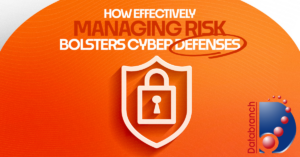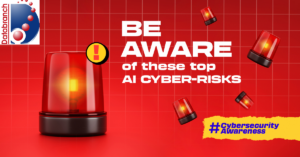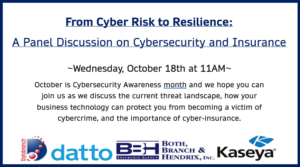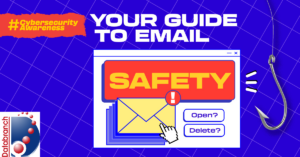
In today’s rapidly evolving digital landscape, where cyberthreats and vulnerabilities continually emerge, it’s obvious that eliminating all risk is impossible. Yet, there’s a powerful strategy that can help address your organization’s most critical security gaps, threats and vulnerabilities — comprehensive cyber risk management.
Implementing a well-thought-out cyber risk management strategy can significantly reduce overall risks and strengthen your cyber defenses. To understand the profound impact of this approach, continue reading as we delve into the nuances that make it a game changer in digital security.
Cyber Risk Management vs. Traditional Approaches
Cyber risk management diverges significantly from traditional approaches, differing in the following key aspects:
Comprehensive Approach
Cyber risk management isn’t just an additional layer of security. It’s a comprehensive approach that integrates risk identification, assessment and mitigation into your decision-making process. This ensures there are no gaps that could later jeopardize your operations.
Beyond Technical Controls
Unlike traditional approaches that often focus solely on technical controls and defenses, cyber risk management takes a broader perspective. It considers various organizational factors, including the cybersecurity culture, business processes and data management practices, ensuring a more encompassing and adaptive security strategy.
Risk-Based Decision-Making
In traditional cybersecurity, technical measures are frequently deployed without clear links to specific risks. Cyber risk management, however, adopts a risk-based approach. It involves Threat Modeling, which is a deep analysis of potential threats, their impact, and likelihood.
Threat modeling helps businesses prioritize their risk management and mitigation strategies. The goal is to mitigate the risk of falling victim to a costly cyber incident
Alignment with Business Objectives
A distinctive feature of cyber risk management is its alignment with your overarching business objectives. It ensures that your cybersecurity strategy takes into account your mission, goals and critical assets, thereby making it more relevant to your organization’s success.
Holistic View of Security
Cyber risk management recognizes the significance of people, processes and technology, embracing a holistic view of security. It acknowledges that a robust security strategy is not solely dependent on technology but also on the people implementing it and the processes that guide its deployment.
This is why Employee Security Awareness training can make such an impact on your businesses cybersecurity posture. You and your colleagues are your company’s greatest risk, but also your greatest asset. Visit us here to learn more about our advanced cybersecurity training program.
Resource Allocation
By prioritizing risks based on their potential impact and likelihood, cyber risk management allows you to allocate resources more effectively. This means that your organization can focus on the areas of cybersecurity that matter the most, optimizing resource utilization.
The Role of Risk Tolerance in Cyber Risk Management
Risk tolerance is a pivotal aspect of enterprise risk management (ERM). It serves as a guiding principle, shaping your organization’s risk-taking behavior, influencing decision-making and providing a framework for achieving objectives while maintaining an acceptable level of risk.
Key components of risk tolerance are:
Willingness to Take Risks
Risk tolerance in cyber risk management is about your organization’s readiness to embrace calculated risks by acknowledging that not all risks can be eliminated. It shapes your organization’s ability to innovate and seize opportunities while maintaining an acceptable level of security risk.
The Capacity to Absorb Losses
This component of risk tolerance assesses your organization’s financial resilience. It’s about having a financial buffer to absorb losses without jeopardizing your core operations, ensuring that you can recover from security incidents without severe disruption.
Consideration of Strategic Objectives and Long-Term Goals
Risk tolerance should be in harmony with your strategic objectives and long-term goals. It ensures that your risk-taking behavior is aligned with your organization’s broader mission, avoiding actions that could undermine your strategic direction.
Visit us here to learn more about how to conduct a Technology Infrastructure Review and how to incorporate the results into your IT objectives roadmap.
Compliance and Regulatory Considerations
Meeting compliance and regulatory requirements is an essential aspect of risk tolerance. It means understanding the legal and regulatory landscape and ensuring that your risk management strategy adheres to these standards, reducing the risk of legal consequences.
Meeting the Expectations of Customers and Stakeholders
A critical part of risk tolerance is understanding and meeting the expectations of your customers and stakeholders. It involves maintaining the trust and confidence of these groups by demonstrating that you prioritize their interests and data security in your risk management approach.
Collaborative Path to Success
Now that you understand how cyber risk management empowers organizations like yours to strengthen your defenses, it’s time to take action. Download our comprehensive checklist to navigate the four essential stages of cyber risk management. This resource will guide you in implementing a tailored strategy that meets your unique needs.
Don’t wait for the next cyberthreat to strike. Reach out to Databranch today at 716-373-4467 option 6, or [email protected] to start the process of making your organization more secure. Together, we’ll enhance your digital defenses, secure your organization’s future and prioritize your security.
Read More

Cybersecurity is an essential aspect of any business or organization. As technology evolves, so do the threats that can harm an organization’s operations, data and reputation. One of the most effective ways to defend against these threats is through the Defense in Depth (DiD) approach.
DiD is a cybersecurity approach in which multiple defensive methods are layered to protect a business. Since no individual security measure is guaranteed to endure every attack, combining several layers of security is more effective.
This layering approach was first conceived by the National Security Agency (NSA) and is inspired by a military tactic with the same name. In the military, layers of defense help buy time.
However, in IT, this approach is intended to prevent an incident altogether.
Essential Elements of DiD
Implementing all the elements of an effective DiD strategy can help minimize the chances of threats seeping through the cracks. These elements include:
1. Firewalls
A firewall is a security system comprised of hardware or software that can protect your network by filtering out unnecessary traffic and blocking unauthorized access to your data.
2. Intrusion Prevention and Detection Systems
Intrusion prevention and detection systems scan the network to look for anything out of place. If a threatening activity is detected, it will alert the stakeholders and block attacks.
3. Endpoint Detection and Response (EDR)
Endpoint detection and response (EDR) solutions constantly monitor endpoints to find suspicious or malicious behavior in real time.
Databranch is excited to announce a new detection software that we have begun implementing for our clients. The Huntress Managed Detection and Response (MDR) for Microsoft 365 secures your users with 24/7 protection.
Huntress MDR can detect and respond to early signs of cyberattacks such as unauthorized access, email manipulation, and suspicious login locations.
The software then utilizes Huntress’s 24/7 Security Operations Center (SOC) which is comprised of experts who analyze and interpret the threats. An actual Huntress employee will review these detections, provide incident reports, and will deliver actionable remediations for recovery.
4. Network Segmentation
Once you divide your business’s network into smaller units, you can monitor data traffic between segments and safeguard them from one another.
5. The Principle of Least Privilege (PoLP)
The principle of least privilege (PoLP) is a cybersecurity concept in which a user is only granted the minimum levels of access/permissions essential to perform their task.
Visit us here to learn more about the risks associated with Local Administrative Privileges.
6. Strong Passwords
Poor password hygiene, including default passwords like “1234” or “admin,” can put your business at risk. Equally risky is the habit of using the same passwords for multiple accounts.
To protect your accounts from being hacked, it’s essential to have strong passwords and an added layer of protection by using practices such as Multi-Factor Authentication (MFA).
7. Patch Management
Security gaps left unattended due to poor patch management can make your business vulnerable to cyberattacks. When a new patch is delivered, deploy it immediately to prevent exploitation.
Databranch offers a Patch Management solution for our managed client’s that automates and manages service packs, hot-fixes, and patches from a single location.
How IT service providers help defend against threats
As a Databranch client, our experienced team members will help you divide DiD into three security control areas:
1. Administrative controls
The policies and procedures of a business fall under administrative controls. These controls ensure that appropriate guidance is available and security policies are followed.
Examples include hiring practices or employee onboarding protocols, data processing and management procedures, information security policies, vendor risk management and third-party risk management frameworks, information risk management strategies, and more.
3. Technical controls
Hardware or software intended to protect systems and resources fall under technical controls.
They include firewalls, configuration management, disk/data encryption, identity authentication (IAM), vulnerability scanners, patch management, virtual private networks (VPNs), intrusion detection systems (IDS), security awareness training and more.
4. Physical controls
Anything that physically limits or prevents IT system access falls under physical controls, such as fences, keycards/badges, CCTV systems, locker rooms and more.
Don’t worry if you are struggling with developing a DiD strategy for your organization. Databranch is here to make things as simple as possible. Contact us at 716-373-4467 option 6, or [email protected] to start the process of making your organization more secure.
Read More

Data loss disasters come in many forms, ranging from full-scale natural calamities to cyberattacks and even simple human errors. Disasters can bring businesses to a grinding halt. Apart from financial and reputational damage, failing to protect valuable data can also result in expensive lawsuits.
That’s why businesses, regardless of size, must have a backup and disaster recovery (BCDR) plan. By implementing a foolproof BCDR, you can quickly get your business back up and running should disaster strike. It will also help you comply with governmental and industry regulatory frameworks.
In this post, we’ll break down the different types of data loss disasters and outline the key BCDR components that can help you make it through a disruptive event with flying colors.
The Many Forms Data Loss Can Take
Let’s analyze the various types of data loss disasters that can hurt your business:
Natural Disasters
This covers everything from storms, hurricanes, floods, fires, tsunamis and volcano eruptions. In most cases, you can expect infrastructural damages, power failure and mechanical failures, which could then lead to data loss.
Hardware and Software Failure
Software and hardware disruption can cause data loss if you don’t have BCDR measures in place. These disruptions could be due to bugs, glitches, configuration errors, programmatic errors, component failures, or simply because the device is at its end of life or the software is outdated.
Unforeseen Circumstances
Data loss can happen due to random, unexpected scenarios. For instance, a portable hard disk held by an employee could get stolen, your server room may have a water leak because of a plumbing issue, or there could even be a pest infestation in one of your data centers.
Human Factor
Human errors are a leading cause of data loss incidents. These errors range from accidental file deletions, overwriting of existing files and naming convention errors to forgetting to save or back up data or spilling liquid on a storage device.
Cyberthreats
Your business may fall prey to malware, ransomware and virus attacks, which could leave your data and backups corrupt and irrecoverable. Additionally, data loss could be caused by malicious insiders with unauthorized access, which often goes under the radar.
Allowing your employees to have administrative privileges can leave holes in your cybersecurity, visit us here to learn more.
Key components of BCDR
Here are a few crucial things to keep in mind as you build a robust BCDR strategy:
Risk Assessment
Identify potential risks and threats that would impact business operations. Measure and quantify the risks to tackle them.
Databranch believes that identifying the right level of security to protect your IT infrastructure begins with a comprehensive security assessment that includes vulnerability/penetration evaluation, assessment reporting and security policy creation.
You can visit our website here to request your FREE baseline security assessment.
Business Impact Analysis (BIA)
Assess the potential consequences of a disruptive event on critical business functions and prioritize them in the recovery plan.
Continuity Planning
Implement procedures to resume critical business operations during disruption, with minimal downtime. Databranch offers our BCDR solution from Datto, the leader in Total Data Protection. Not only will Datto backup all your data to the device itself, but it will also backup everything to 2 separate offsite cloud storage locations.
So, in the event that the local device is destroyed, your business can be up and running in just minutes.
Disaster Recovery Planning
Plan a well-defined business resumption plan to recover critical IT functions and data following a disruptive incident. With a recovery plan in place, many businesses may simply never recover.
Do you know the cost of downtime for your business? If not, visit our website here to view our Recovery Time Calculator.
Testing and Maintenance
Periodically test your disaster recovery and backup plans to ensure they can be recovered in a disaster. If they fail, you can work on the enhancement.
Wondering Where to Begin?
Developing and implementing a BCDR plan on your own can be daunting. However, we can help you build the right BCDR strategy for your business profile.
Databranch has the knowledge and experience to take care of your backup and BCDR needs. Get in touch with us today at 716-373-4467 option 6, [email protected].
You can also download our infographic below to learn more about planning for potential data loss.
Read More

Even on a good day, being a business owner is challenging. Apart from dealing with and effectively solving multiple problems, you also need the foresight to arm your business with the right tools and solutions to tackle any issues that might arise later.
One issue you should always prioritize is data loss/data corruption and business disruption that cause downtime and productivity dips. Remember that data loss/data corruption and business disruption could happen due to various reasons, such as:
- Natural calamity
- Hardware failure
- Human error
- Software corruption
- Computer viruses
Adopting a comprehensive backup and business continuity and disaster recovery (BCDR) strategy is the best way to tackle this problem.
What is a comprehensive backup and BCDR strategy?
A comprehensive backup and BCDR strategy emphasizes the need for various technologies working together to deliver uptime. It even highlights technologies associated with cybersecurity. A robust strategy:
Protects All Systems, Devices and Workloads
Managing all systems, devices and workloads efficiently, securely and consistently can be challenging. Mistakes, errors, mishaps and outright failures across backup and recovery systems could happen at any time, leading to severe downtime or other costly business consequences.
That’s why it’s essential to have a reliable and secure solution to back up and protect business data as well as business systems, devices and workloads.
Ensures the Integrity, Availability and Accessibility of Data
The complexity of IT, network and data environments that include multiple sites — cloud, on-premises and remote — makes monitoring and protection difficult. It negatively affects the integrity, availability and accessibility of information and all IT network assets. That’s why it’s a best practice to simultaneously deploy tools or systems that cover all IT and network infrastructure (remote, cloud and on-site) with the same level of protection and security.
Enables Business Resilience and Continuity
A comprehensive and realistically achievable backup and BCDR strategy prioritizes, facilitates and ensures the continuity of business operations. It represents a business’ resiliency against downtime or data loss incidents.
Prioritizes Critical Protection and Security Requirements Against Internal and External Risks
No backup or BCDR solution can be effective if your business does not proactively identify and mitigate internal and external risks. You need tools that focus on internal and external threats through constant monitoring, alerting and tactical defense to empower your backup and BCDR strategy.
Databranch offers a suite of cost-effective computer managed services that proactively monitor and support your network and Technology infrastructure.
Optimizes and Reduces Storage Needs and Costs Through Deduplication
With the amount of data skyrocketing day after day, it poses serious storage and budgetary challenges for businesses. What makes things worse is the existence of multiple unnecessary copies of the same files.
Therefore, adopting the deduplication process can identify data repetition and ensure that no similar data is stored unnecessarily.
Manages Visibility and Unauthorized Access and Fulfills Data Retention Requirements
Your business data must never be visible to every employee in the same way. There must be policies and tools to ensure that an employee accesses only data essential to completing their tasks. Click here to reach more on the risks associated with Administrative Privileges.
Also, unauthorized access must be identified and blocked immediately. This is crucial not only for the success of backups and BCDR but also for maintaining compliance with all regulatory mandates related to data protection and retention.
Comprehensive Backup and BCDR for Your Business
By now, it must be clear to you that adopting a comprehensive backup and BCDR strategy is not an option but a necessity. An occasional, severe data loss incident or disruption could even open the gates for your competitors to eat into your profits and customer base.
You must do everything possible to bring all the right tools and strategies together so your business can operate seamlessly, even in the face of chaos.
Databranch offers our BCDR solution from Datto, the leader in Total Data Protection. Not only will the Datto backup all your data to the device itself, but it will also backup everything to 2 separate offsite cloud storage locations.
So, in the event that the local device is destroyed, you can still access your information even from a remote location.
With Datto you will receive daily backup verifications and screen shots of your virtual servers give you peace of mind and ensure that your backup data is working and accessible to you when you need it.
Are you ready to approach the concept of comprehensive backup and BCDR practically? It isn’t as difficult as you might think.
Databranch has the knowledge and experience to take care of your backup and BCDR needs. Get in touch with us today at 716-373-4467 option 6, [email protected], or click here to learn more.
Read More

Cybercriminals are always looking for new ways to bypass security defenses. That’s why it’s essential to think like a hacker and adopt measures to stay ahead of them. This is what Defense in Depth (DiD) is all about.
The National Institute of Standards and Technology (NIST) defines DiD as “The application of multiple countermeasures in a layered or stepwise manner to achieve security objectives. The methodology involves layering heterogeneous security technologies in the common attack vectors to ensure that attacks missed by one technology are caught by another.”
In simple terms, DiD is a cybersecurity approach in which multiple defensive methods are layered to protect a business. Since no individual security measure can guarantee protection against every attack, combining several layers of security can be more effective.
Before you start your DiD journey, it’s crucial to stay informed about the changing threat landscape.
9 Threats to Protect Your Business Against
While there are numerous threats that businesses like yours must be aware of, let’s look at some of the most common.
1. Ransomware
Ransomware is a type of malware that threatens to disclose sensitive data or blocks access to files/systems by encrypting it until the victim pays a ransom. Failure to pay on time can lead to data leaks or permanent data loss.
2. Phishing/Business Email Compromise (BEC)
Phishing involves a hacker masquerading as a genuine person/organization primarily through emails or other channels like SMS. Malicious actors use phishing to deliver links or attachments that execute actions such as extracting login credentials or installing malware.
Business email compromise (BEC) is a scam that involves cybercriminals using compromised or impersonated email accounts to manipulate victims into transferring money or sharing sensitive information.
3. Cloud Jacking
Cloud jacking, or hijacking, entails exploiting cloud vulnerabilities to steal an account holder’s information and gain server access. With more and more companies adopting cloud solutions, IT leaders are worried about cloud jacking becoming a significant concern for years to come.
4. Insider Threats
An insider threat originates from within a business. It may happen because of current or former employees, vendors or other business partners who have access to sensitive business data. Because it originates from the inside and may or may not be premeditated, an insider threat is hard to detect.
5. Denial-of-Service/Distributed Denial-of-Service (DoS and DDoS)
These attacks are common and easy to carry out. In a DoS or DDoS attack, hackers flood the targeted system with multiple data requests, causing it to slow down or crash.
6. Artificial Intelligence (AI) and Machine Learning (ML) Hacks
Artificial intelligence (AI) and machine learning (ML) are trending topics within the IT world for their path-breaking applications. However, AI and ML help hackers more efficiently develop an in-depth understanding of how businesses guard against cyberattacks.
7. Internet of Things (IoT) Risks and Targeted Attacks
IoT devices are a favorite target of cybercriminals because of the ease of data sharing without human intervention and inadequate legislation.
8. Web Application Attacks
Vulnerabilities within web applications permit hackers to gain direct access to databases to manipulate sensitive data. Business databases are regular targets because they contain sensitive data, including Personally Identifiable Information (PII) and banking details.
9. Deepfakes
A deepfake is a cyberthreat that uses artificial intelligence to manipulate or generate audio/video content that can deceive end users into believing something untrue.
Get Up and Running with DiD
To keep sophisticated cyberthreats at bay, you need a robust DiD strategy. Your strategy should involve layering multiple defensive methods, like firewalls, intrusion prevention and detection systems, endpoint detection and response (EDR) and more, to build a security fortress that’s hard to crack.
DiD is an undertaking that requires time and effort. That’s why collaborating with a partner like Databranch, who can implement and maintain your DiD strategy while you focus on your business, is ideal.
If you want to learn more about how DiD can help protect your business, download our free eBook “7 Elements of an Effective Defense in Depth (DiD) Security Strategy.”
You can also reach out to one of our experienced team members at 716-373-4467 option 6, or [email protected].
Read More

The rise of AI has sparked a revolution. Everyone, from industry giants to smaller enterprises, is captivated and eager to leverage AI’s endless possibilities.
However, amid the celebrations of AI’s merits, let’s not ignore its potential risks. A new array of cyberthreats emerges when intricate AI algorithms cross paths with malicious cyber elements. From AI-powered phishing schemes to ultra-realistic deepfakes, these dangers serve as a reminder to stay vigilant and prepared.
In this blog, we embark on a journey to explore AI benefits and risks. Our aim is to guide you in harnessing AI’s strengths while safeguarding against its potential pitfalls.
AI’s Positive Impact on Business
The top benefits of AI include:
Smart Data Analysis
AI’s expertise lies in swiftly deciphering massive data sets to uncover patterns. This ability proves invaluable in traversing through modern markets. The insights derived empower you to make well-founded decisions, steering clear of guesswork.
Boosted Productivity
AI’s automation prowess liberates your employees from mundane tasks, helping them focus on more critical tasks. Tedious and manual work can now be done seamlessly without human intervention, boosting productivity.
Faster Business Maneuvering
In an ever-evolving technological landscape, keeping up to date is paramount. AI empowers you to process and respond to real-time information promptly. This agility enables swift reactions to evolving scenarios, customer demands and opportunities.
AI’s Cyber Challenges
As we delve into the world of AI, we must also acknowledge the potential risks:
AI-powered Phishing Scams
Sneaky cybercriminals employ AI-driven chatbots to create impeccable phishing emails without the usual red flags, such as grammar errors. These attacks exploit human vulnerabilities, luring even the most vigilant to share sensitive information.
To bolster your defense, exercise caution with emails from unfamiliar sources. Scrutinize sender details, avoid suspicious links and employ anti-phishing tools for added protection.
Malicious AI-Generated Code
Cybercriminals harness AI tools for swift code generation, surpassing manual capabilities. These generated code snippets find their way into malware and other malicious software.
Defend against these intricate schemes by educating your team about them. Strengthen your defenses through layered security measures, such as firewalls, antivirus software and automated patch management.
Is your company looking for on-going cybersecurity training? Our Breach Prevention Platform and Security Awareness Training will give your employees the resources they need to spot real world phishing attempts. Contact Databranch today to learn more!
Deepfakes and Impersonations
AI-generated deepfakes can propagate misinformation, deceiving unsuspecting individuals and leading to fraud or character defamation. For example, in the current era, where many banks rely on online KYC (KYC or Know Your Customer is commonly implemented in banks to comply with regulatory requirements and mitigate the risk of financial crimes), malicious actors can create ultra-realistic videos using another person’s voice and image samples to open accounts for illegal transactions.
Identifying deepfakes necessitates a discerning eye. Among other factors, anomalies in skin texture, blinking patterns and facial shadows help distinguish genuine content from manipulated content.
Collaborative Path to Success
At the crossroads of innovation and challenges, knowledge takes center stage.
Our comprehensive eBook, “Shielding Your Enterprise: A Guide to Navigating AI Safety,” stands as your compass in the AI landscape. Fill out the form below to delve into AI’s intricacies and acquire strategies for responsible and secure utilization in your business.
If you need expert guidance, Databranch is here to help you navigate todays threat landscape. Contact us today at 716-373-4467 x6 or [email protected] and together, we’ll navigate AI’s realm, harness its power and ensure your organization’s safety.
Read More

Social media has significantly transformed the way we communicate and do business. However, this growing popularity also comes with potential risks that could cause harm to businesses like yours.
Unfortunately, many organizations remain unaware of these rapidly evolving challenges. In this blog, we will explore the dangers associated with social media and share practical tips to safeguard your organization’s reputation and financial stability so that you can safely reap the benefits of social media platforms.
Exploring the Risks
Social media presents several risks that you need to address, such as:
Security Breaches
Cybercriminals can exploit social media to steal sensitive information by creating fake profiles and content to trick people into sharing confidential data. Social media platforms are also vulnerable to hacking, which can have a negative impact on your business.
Reputation Damage
Negative comments from dissatisfied customers, envious competitors or even unhappy employees can quickly spread online and cause significant damage to your brand’s image within seconds.
Employee Misconduct
Certain employees may share offensive content or leak confidential information on social media, which can trigger a crisis that can be challenging for business leaders to handle.
Legal Accountability
Social media has the potential to blur the boundaries between personal and professional lives, which can, in turn, create legal liabilities for your business. If your employees make malicious remarks about competitors, clients or individuals, the public can hold you responsible for their actions. Employees may also face the consequences if their social media behavior violates the organization’s regulations.
Phishing Threats
Social media phishing scams can target your business and employees by installing malware or ransomware through seemingly authentic posts.
Fake LinkedIn Jobs
Cybercriminals often pose as recruiters on LinkedIn and post fake job listings to collect data for identity theft scams.
Securing Your Business
Taking proactive measures is essential to avoid social media risks, including:
Checking Privacy Settings
Set privacy settings to the highest level across all accounts, restricting your and your employees’ access to sensitive information. This includes removing Local Admin Privileges for employees.
Strengthening Security
Employ robust passwords and multifactor authentication (MFA) to bolster account security.
Establishing Clear Guidelines
Enforce clear social media rules for company and personal devices, customizing policies to fit your industry’s unique risks.
Educating Your Teams
Educate your team on social media risks, imparting safe practices to thwart scams and phishing attempts. Our Employee Cybersecurity Training not only offers an annual cybersecurity training, but also contains weekly micro-trainings to keep your employees up to date on real world threats.
Identifying Impersonation
Develop protocols to detect and manage fake profiles and impersonations swiftly. Remain vigilant and report any suspicious activity.
Vigilant Monitoring
Set up a system to monitor social media, promptly addressing fraudulent accounts or suspicious activity that could stain your brand image.
Act Now to Safeguard Your Business
Understanding the risks and adhering to social media best practices are crucial for businesses of all sizes. By following these guidelines, you can reduce your business’s vulnerability while reaping the rewards of social media.
For comprehensive insights into social media safety, download our eBook “From Vulnerability to Vigilance: Social Media Safety.”
Reach out to Databranch today at 716-373-4467 option 4 or [email protected] if your business is looking to increase their cybersecurity awareness.
Read More

Databranch is partnering with Both Branch & Hendrix Inc. along with Datto to present a webinar on Wednesday, October 18th at 11AM, titled “From Cyber Risks to Resilience: A Panel Discussion on Cybersecurity and Insurance.“
In this session we will discuss:
- How A Cyberinsurance Policy Works
- What a Standard Cyber Policy Includes
- Rise in Business Email Compromises
- Good Password Hygiene
- End-User Security Training/Phishing Awareness
- Business Continuity – Recoverability in the Event of a Cyber Incident – BC/DR & Datto SaaS
- and more!
In our increasingly interconnected world, cyber threats continue to evolve at an alarming rate, posing significant risks to individuals and their organizations.
As we venture into the future, it is crucial to anticipate the potential threats and understand the importance of implementing robust cybersecurity measures.
Join us to learn from:
- Mike Hendrix – an Accredited Advisor in Insurance (AAI) that has been with Both, Branch & Hendrix since 1983.
- Mike Wilson – the President of Databranch, a MSP company serving local, national and international businesses since 1985.
- Taylor Thorson – a Channel Development Manager for Datto/Kaseya, the leader in Total Data Protection.
October is Cybersecurity Awareness month and we hope you can join us as we discuss the current threat landscape, how your business technology can protect you from becoming a victim of cybercrime, and the importance of cyber-insurance.
Register for our webinar here! Reach out to Databranch today at 716-373-4467 option 6, or [email protected] to learn how we can enhance your businesses cybersecurity posture.
Read More

Phishing scams remain one of the most prevalent and successful types of cyberattacks today, so being aware of the danger they pose to businesses like yours is extremely crucial. Your business could easily be the next victim if you don’t clearly understand how threat actors leverage phishing emails.
In this blog, you’ll learn the intent behind phishing emails, the various types of phishing attacks, and most importantly, how you can secure your email and business.
The Goal Behind Phishing Emails
Cybercriminals use phishing emails to lure unsuspecting victims into taking actions that will affect business operations, such as sending money, sharing passwords, downloading malware or revealing sensitive data. The primary intent behind a phishing attack is to steal your money, data or both.
Financial theft — The most common aim of a phishing attempt is to steal your money. Scammers use various tactics, such as business email compromise (BEC), to carry out fraudulent fund transfers or ransomware attacks to extort money.
Data theft — For cybercriminals, your data, such as usernames and passwords, identity information (e.g., social security numbers) and financial data (e.g., credit card numbers or bank account information), is as good as gold. They can use your login credentials to commit financial thefts or inject malware. Your sensitive data can also be sold on the dark web for profit.
Be vigilant and look out for these phishing attempts:
- If an email asks you to click on a link, be wary. Scammers send out phishing emails with links containing malicious software that can steal your data and personal information.
- If an email directs you to a website, be cautious. It could be a malicious website that can steal your personal information, such as your login credentials.
- If an email contains an attachment, be alert. Malicious extensions disguised to look like a document, invoice or voicemail can infect your computer and steal your personal information.
- If an email tries to rush you into taking an urgent action, such as transferring funds, be suspicious. Try to verify the authenticity of the request before taking any action.
Different Types of Phishing
It’s important to note that phishing attacks are constantly evolving and can target businesses of all sizes. While phishing emails are a common method used by cybercriminals, they also use texts, voice calls and social media messaging.
Here are the different kinds of phishing traps that you should watch out for:
Spear phishing — Scammers send highly personalized emails targeting individuals or businesses to convince them to share sensitive information such as login credentials or credit card information. Spear phishing emails are also used for spreading infected malware.
Whaling — A type of spear phishing, whale phishing or whaling is a scam targeting high-level executives where the perpetrators impersonate trusted sources or websites to steal information or money.
Smishing — An increasingly popular form of cyberattack, smishing uses text messages claiming to be from trusted sources to convince victims to share sensitive information or send money.
Vishing — Cybercriminals use vishing or voice phishing to call victims while impersonating somebody from the IRS, a bank or the victim’s office, to name a few. The primary intent of voice phishing is to convince the victim to share sensitive personal information.
Business email compromise (BEC) — A BEC is a spear phishing attack that uses a seemingly legitimate email address to trick the recipient, who is often a senior-level executive. The most common aim of a BEC scam is to convince an employee to send money to the cybercriminal while making them believe they are performing a legitimate, authorized business transaction.
Angler phishing — Also known as social media phishing, this type of scam primarily targets social media users. Cybercriminals with fake customer service accounts trick disgruntled customers into revealing their sensitive information, including bank details. Scammers often target financial institutions and e-commerce businesses.
Brand impersonation — Also known as brand spoofing, brand impersonation is a type of phishing scam carried out using emails, texts, voice calls and social media messages. Cybercriminals impersonate a popular business to trick its customers into revealing sensitive information. While brand impersonation is targeted mainly at the customers, the incident can tarnish the brand image.
Bolster Your Email Security
Emails are crucial for the success of your business. However, implementing email best practices and safety standards on your own can be challenging. That’s why you should consider partnering with a Managed IT service provider like Databranch.
We have the resources and tools to protect your business from cyberattacks, helping you to focus on critical tasks without any worry. We also have ongoing and interactive employee cybersecurity training that will help your company keep up with cybercriminals and their ever-changing tactics.
Meanwhile, to learn how to secure your inbox, download our eBook — Your Guide to Email Safety — that will help you improve your email security and avoid potential traps.
Read More

Your business, in all likelihood, already faces numerous challenges in today’s tech-driven world. However, the aftermath of an unexpected disaster can push your organization to its breaking point. This unintentionally creates opportunities for cybercriminals to launch devastating attacks, amplifying the chaos caused by such events.
Disaster preparedness should be a top priority for your business — not only for physical resilience but also for fortifying your digital defenses. By understanding how disasters fuel cyberattacks, you can proactively safeguard your business against these deceptive threats.
Understanding How Disasters Amplify Cyberthreats
Let’s look at four major ways disasters amplify cyberthreats and what strategies you can utilize to bolster your cybersecurity posture in the face of adversity.
1. Leveraging Diverted Attention and Resources
When a disaster strikes, the immediate focus shifts toward safety and recovery. Unfortunately, this diverts attention and resources away from maintaining and protecting your IT systems and networks.
With a reduced emphasis on cybersecurity measures, essential updates and monitoring may be overlooked, leaving your networks vulnerable to intrusion. Cybercriminals seize this opportunity to infiltrate your systems, compromise sensitive data and disrupt your operations.
To tackle this situation, establish a dedicated team responsible for monitoring and maintaining cybersecurity, even during times of crisis. For our managed clients, Databranch takes this one step further by implementing automated security systems to scan for vulnerabilities and apply necessary patches continuously.
By ensuring cybersecurity remains a priority, even in challenging times, you can minimize the risk of cyberattacks
2. Exploiting Fear, Urgency, Chaos and Uncertainty
Disasters create an environment of fear, urgency, chaos and uncertainty — prime conditions for cybercriminals to thrive in. They launch targeted attacks, such as deceptive emails or fraudulent websites, capitalizing on the sense of urgency and the need for quick solutions. By manipulating individuals into disclosing sensitive information, cybercriminals gain unauthorized access to critical systems. They could also sell this sensitive data on the dark web.
To combat this, educate your employees about the tactics used in phishing attacks and social engineering scams. Train them to recognize warning signs, such as suspicious emails or requests for sensitive information. Encourage a culture of skepticism and verification, where employees double-check the authenticity of requests before sharing confidential data.
By fostering a vigilant and informed workforce, you can fortify your defense against cybercriminals seeking to exploit fear and uncertainty. Visit us here to download our cybersecurity culture checklist.
3. Damaging Critical Infrastructure
Disasters can cause severe damage to your critical infrastructure, compromising components integral to your cybersecurity measures. Destruction of servers, routers or firewalls can weaken your defense mechanisms, allowing cybercriminals to exploit security gaps.
To address this challenge, ensure your critical infrastructure has backup and disaster recovery in place. Regularly back up your data, store it securely off-site or in the cloud, and test the restoration process to ensure it functions smoothly. Implement robust disaster recovery and business continuity plans, including provisions for cybersecurity.
By maintaining resilient infrastructure and regularly testing your backup and recovery processes, you can mitigate the impact of infrastructure damage on your cybersecurity.
4. Impersonation and Deception
In the wake of a disaster, cybercriminals often exploit the trust associated with relief organizations and government agencies. By impersonating these trusted sources, they deceive victims through phishing emails, messages or calls, tricking them into divulging sensitive information or engaging in fraudulent transactions.
To protect yourself from such scams:
- Encourage your employees to verify the authenticity of any communication received during a disaster.
- Advise them to independently contact the organization or agency through known, trusted channels to confirm the legitimacy of any requests.
- Establish robust security awareness training programs that educate employees about common impersonation tactics and teach them how to report them effectively.
By promoting a culture of caution and verification, you can defend against impersonation and deception tactics used by cybercriminals. Our phishing infographic is a great educational resource that can be shared with your workforce to prepare them for real life threats.
Act Now to Safeguard Your Business
Now that we know how cybercriminals can target your business during a disaster, prioritizing disaster preparedness and implementing the above-highlighted measures are important to navigate today’s ever-evolving technology landscape.
If you need expert guidance, Databranch is here to help fortify your disaster preparedness and cybersecurity efforts. Together, let’s ensure a resilient and secure future for your business. Contact us today at 716-373-4467 x6 or [email protected] to proactively safeguard what you’ve worked so hard to build.
Read More


















